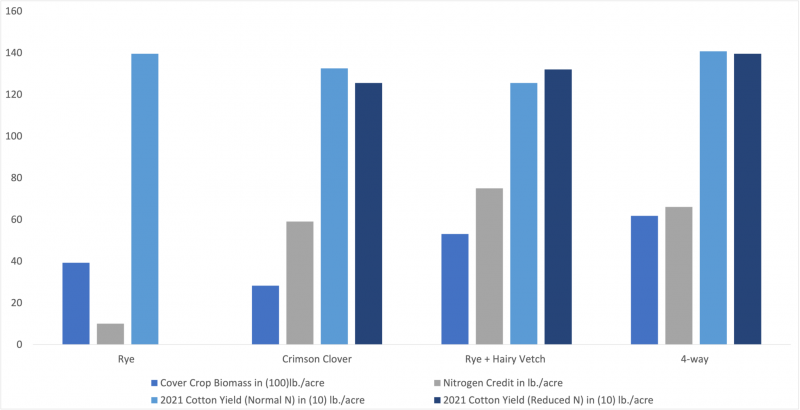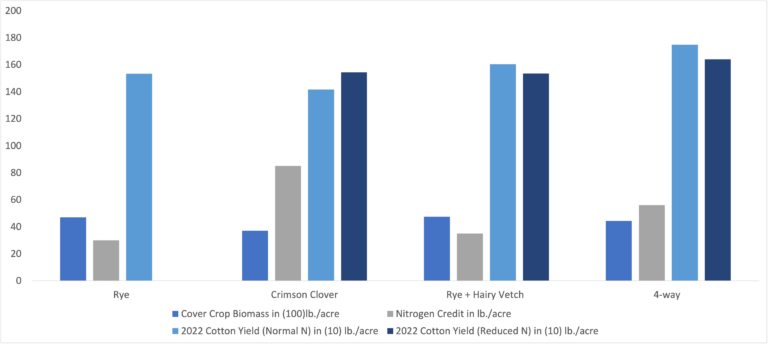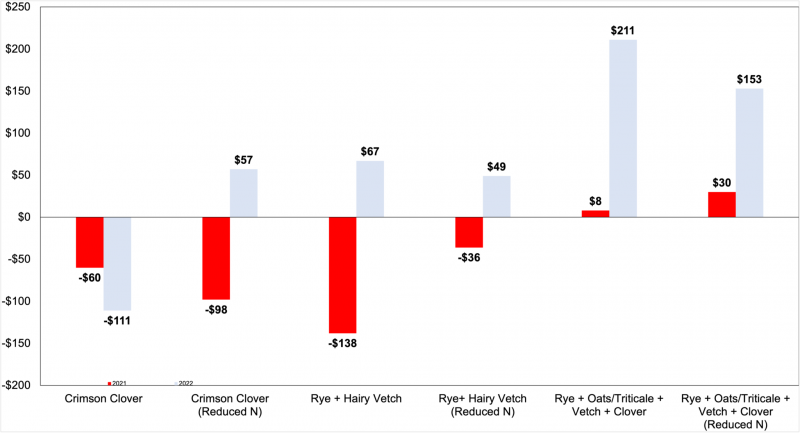Source: Southern Ag Today – Wednesday, September 27, 2023
Kelvin Bobbie, Seth McAllister, Amanda Smith, and Yangxuan Liu, UGA Department of Agricultural and Applied Economics
Interest among producers in adopting cover crops to enhance soil fertility, mitigate erosion, and manage weeds has been growing. Legumes, which are cover crops capable of fixing nitrogen, are recognized for enhancing soil health. In the Southern United States, where crops like cotton play a central role in crop rotations, there exists a pronounced nitrogen demand and a heightened risk of soil erosion due to limited crop residue post-harvest. The use of single-species cereals such as wheat or rye as a soil cover is a common practice. Although adoption remains modest, legume cover crops have the potential to not only minimize soil erosion, but also reduce the need for nitrogen fertilizers, possibly increasing profits relative to single-species cover crops lacking legumes.
A 2-year on-farm trial was conducted in 2021 and 2022 in Terrell County, Georgia, to compare the use of various cover crop treatments in cotton production. The experiment consisted of 3 study treatments relative to a base treatment of a single species rye cover crop.
Base: a single-species rye cover crop (Rye)
Treatment 1: a single-species crimson clover cover crop (Crimson Clover)
Treatment 2: a combination of rye and hairy vetch cover crop (Rye + Hairy Vetch)
Treatment 3: a 4-way mix of rye, vetch, triticale/oats, and crimson clover as cover crop (4-way)
The biomass of the cover crops from each plot was weighed, and the UGA Cover Crop Calculator was used to estimate the nitrogen credit, additional nitrogen released into the soil once the cover crop decays. Two separate subplots were designated: A) a standard fertilizer application determined by the farmer (Normal N), assuming no nitrogen credits, and B) a reduced nitrogen fertilizer application (Reduced N), which in 2021 was based on the anticipated nitrogen credit, and in 2022 was fixed at 40lbs./acre assuming farmer had a budget constraint. Since all treatments adopted cover crops, costs like irrigation, planting, and termination of cover crops were the same. The potential profit impact of each treatment relative to the base treatment is compared using a partial budget approach.
Figures 1 and 2 illustrate, for 2021 and 2022, respectively, the cover crop biomass weighed, the nitrogen credit released into the soil after cover crop decay, and cotton yields for both Normal N and Reduced N subplots. The graphs show that in both years, all treatments produced almost as much, if not more, biomass than the rye treatment. Nitrogen credited to the soil was also found to be higher in all treatments across both years. The nitrogen credit observed for multi-species treatments exhibited a discernible decline between 2021 and 2022, primarily attributed to reduced legume establishment during the latter year, which was influenced by adverse weather conditions experienced in 2022. This gives credence to the nitrogen-fixing ability of legumes when they are adequately incorporated as cover. Cotton yields varied across time for the rye and hairy vetch treatment as they were as good or better than the base of rye in the year 2022 but not in 2021. But, the 4-way treatment, consistently, across years, produced yields as good as the base or even better. Figure 3 uses profits from the base treatment as a baseline against which profits from all other treatments were compared. The graph showed that the 4-way treatment provided higher profit per acre across 2021 and 2022.

Figure 1. 2021 biomass weight, estimated nitrogen credit, and cotton yield from single and multi-species cover crop treatments.

Figure 2. 2022 biomass weight, estimated nitrogen credit, and cotton yield from single and multi-species cover crop treatments.
–
While only illustrating the experience of two seasons in a single location, the Terrell County, GA study provides insight into the potential to offset nitrogen expenses by using multi-species cover crops (including legumes) in cotton production. Single species clover and dual-species (rye/vetch) generally performed better than rye in 2022, but did not in 2021. These mixed results of the lower variety treatments might shed some light on producers’ tendency to stick with a single species rye cover. However, a high variety, 4-species mixed cover crop had an improved profit outcome relative to a simple rye cover crop in both 2021 and 2022 as well as across all nitrogen application strategies. Results will obviously vary by season, geography, and primary crop, but the high variety cover was the better performer in this instance.

Figure 3. Per acre profit differential for each cover crop treatment relative to the per acre profit of single species rye as cover crop (considering differences in yield, resulting revenue, cover crop seed costs, and nitrogen costs per acre). Bars – Red 2021 & Grey 2022.
